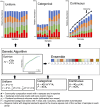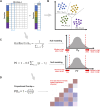Specialty grand challenge: how can we use integrative approaches to understand microbial community dynamics?
- PMID: 40809114
- PMCID: PMC12342006
- DOI: 10.3389/fsysb.2024.1432791
Specialty grand challenge: how can we use integrative approaches to understand microbial community dynamics?
Keywords: ecology; integrative “omics”; microbiology; multivariate statistical analyses; regression analysis.
Conflict of interest statement
The authors declare that the research was conducted in the absence of any commercial or financial relationships that could be construed as a potential conflict of interest. The author(s) declared that they were an editorial board member of Frontiers, at the time of submission. This had no impact on the peer review process and the final decision.
Figures










Similar articles
-
Whole-Person Healing to the People: Culturally Affirming and Community-Based Approaches to Integrative Health Equity.Glob Adv Integr Med Health. 2025 Jul 4;14:27536130251357522. doi: 10.1177/27536130251357522. eCollection 2025 Jan-Dec. Glob Adv Integr Med Health. 2025. PMID: 40620320 Free PMC article.
-
The health economics of insulin therapy: How do we address the rising demands, costs, inequalities and barriers to achieving optimal outcomes.Diabetes Obes Metab. 2025 Jul;27 Suppl 5(Suppl 5):24-35. doi: 10.1111/dom.16488. Epub 2025 Jun 4. Diabetes Obes Metab. 2025. PMID: 40464081 Free PMC article.
-
Integrative systems biology approaches for analyzing microbiome dysbiosis and species interactions.Brief Bioinform. 2025 Jul 2;26(4):bbaf323. doi: 10.1093/bib/bbaf323. Brief Bioinform. 2025. PMID: 40619813 Free PMC article. Review.
-
Microbiomes in animal ecology: Advances, assumptions, and opportunities.Integr Comp Biol. 2025 Jun 28:icaf112. doi: 10.1093/icb/icaf112. Online ahead of print. Integr Comp Biol. 2025. PMID: 40580119
-
Designing causal mediation analyses to quantify intermediary processes in ecology.Biol Rev Camb Philos Soc. 2025 Aug;100(4):1512-1533. doi: 10.1111/brv.70011. Epub 2025 Mar 9. Biol Rev Camb Philos Soc. 2025. PMID: 40059404 Review.
References
-
- Anderson M. J., Legendre P. (1999). An empirical comparison of permutation methods for tests of partial regression coefficients in a linear model. J. Stat. Comput. Simul. 62 (3), 271–303. 10.1080/00949659908811936 - DOI
-
- Andries E., Nikzad-Langerodi R. (2022). Dual-constrained and primal-constrained principal component analysis. J. Chemom. 36 (5), e3403. 10.1002/CEM.3403 - DOI
Publication types
LinkOut - more resources
Full Text Sources

